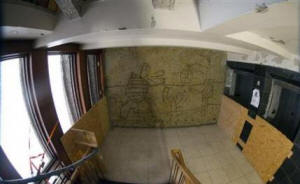 |
|

Picassos
may face wrecking ball in bombed-out Oslo buildings
[December 16, 2013] OSLO (Reuters) — Five Picasso designs etched into concrete may face the wrecking ball at government buildings in Oslo that anti-Islam militant Anders Breivik bombed in 2011.
|
Spread across two buildings, including the prime minister's
17-storey High Block office, the Picassos were etched in 1958.
They are the first Picassos in concrete and four of them were
especially designed for the site. Norway is debating what to do with the damaged buildings after
eight people were killed in the bombing, after which Breivik
killed 69 more people, mostly teenagers, at the ruling Labour
party's summer camp. The new government, in office since October, is expected to
consider the issue next spring and government officials insist
no decision has been made. "This is a highly emotional debate," Paal Weiby, a spokesman for
government's property manager Statsbygg, said. "A lot of people would be terrified to go back" to work at the
building, he said. "But others say that this building is a
symbol and if you tear it down, the terrorist wins." The works, discolored from years of cigarette smoke, were etched
into the concrete by Picasso's friend, the Norwegian artist Carl
Nesjar whose own works also decorate the buildings. The Picassos include "The Beach," "The Seagull," "Satyr and
Faun" and two versions of "The Fishermen". Most are about 3m
(yards) wide but the outdoor version of the latter is 13m wide. Breivik's bomb left a crater two stories deep, bent steel beams
and shattered concrete, damaging the High Block so badly that a
government-sponsored study recommended knocking it down, arguing
that a new building would save 400 million crowns ($65 million). "Sure, but then you just finish Breivik's work," Oslo student
Sofia Hagen, 19, said. "Imagine how happy that would make him." Some of the artworks could be moved, but critics say they do not
belong elsewhere and not all of them could be saved. (Reporting by Balazs Koranyi; diting by Michael Roddy and Louise Ireland) [© 2013 Thomson Reuters. All rights reserved.] Copyright 2013 Reuters. All rights reserved. This material may not be published,
broadcast, rewritten or redistributed.
|
 |
|
|
|

